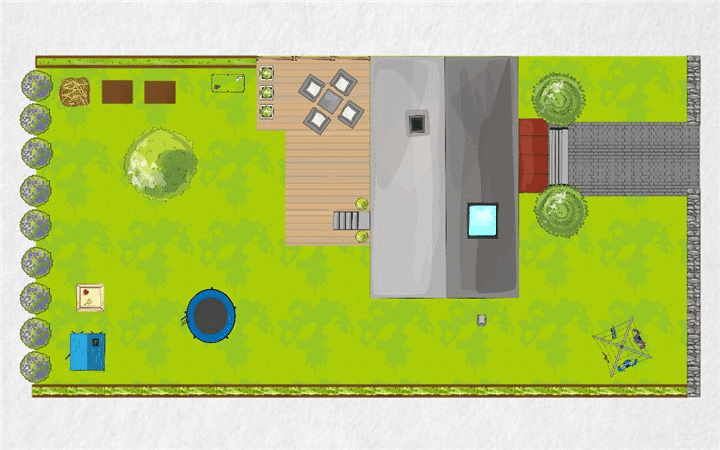Updated landscaping touches can make your address more appealing to you, your neighbors and/or your potential new buyers. In fact, real estate experts say that nice curb appeal can add 14% resell value and help your home sell six times faster.
As the saying goes, “You only have one chance to make a first impression.” So whether you’re selling your house or simply ready to add value to your current home, we suggest you get out the shovel and think outside the box.
Here are some slow but steady changes you can make to make a beautiful space outside your front door.
Start by Mapping Out Your Space
Careful planning will keep you on-task and on-budget throughout the landscaping process. First, sketch a rough design of your yard, drawing in what you think might work well, like paths, gardens, and trees. You could also use a tool like Gardena Garden Planner to visualize your space online.
This is a great time to gather ideas on how you get the most out of your outdoor areas. Can you capitalize on great views, sunrises/sunsets, or extend your current indoor space to the great outdoors? Bonus points for creative solutions that provide options for more outdoor living.

Deck, Concrete, or Pavers
A large outdoor space for extra seating, eating, or entertaining is on the wishlist of many homeowners. How you approach the construction of such a feature depends on the slope of your yard, the weather in your area, the size of your space, your preference for certain materials, and your budget. You will want to include the space on your plan and then heavily research your options to get the most bang for your buck.
Choosing the Right Path
Paths that help you, your family (including your fur babies), friends, and neighbors navigate your new outdoor oasis are also a must. Consider how people will enter the area (back door, side gate, etc.) and meander through the space as you decide where your paths should go. And as you choose the materials for your pathways, remember crushed gravel sticks to paws and little ones often trip or stub their toes on uneven pavers.
Time to Revisit Your Budget
Now that you have a plan in place, it’s time to cross-reference your wish list with your determined project budget. Hardscapes such as pavers, stones, and rocks are more expensive, so get a feel for how much you can allocate to these areas as indicated on your plan. Trees are another element that can quickly use up your earmarked funds. Here’s when you prioritize your needs, wants, and must-haves, and then refine your design to make your money go further.
Love Your Lawn, Don’t Just Live With It
You will want a lawn that takes less maintenance to thrive; giving you more time to enjoy the space you’re creating. Not every kind of grass will work in your climate. Do some research, and plan accordingly. If you live in a hot area, a drought-resistant variety like Bermuda grass would be better than Kentucky bluegrass, which does better in the cold.
How Will Your Garden Grow
Most importantly, know your planting zone. You will save a lot of money, time, and headache if you choose plants that are hardy for your area based on your planting zone. Then create six to eight-foot deeps garden beds that follow a general rule of 50% evergreens, 25% deciduous (or flowering) shrubs, and 25% perennials. Include a mix of plants that bloom at different times and there will always be something to admire! Sufficient spacing between each plant will also ensure that your garden continues to grow beautifully for years to come.
Be sure to plant your garden far enough away from the exterior your home to give room for upkeep, protect the façade and keep unwanted pests from using the garden as a highway into your home.
Laying down a two to four-inch layer of mulch can help combat weeds and keep your plants’ roots warm and well-fed. Avoid mulch around shrubbery or other plants with roots close to the surface, or they will be smothered rather than provided for.
Trees
Trees provide great shade, beauty, and curb appeal. Plan their placement carefully. Root systems, preference for particular soil conditions, and size at maturity must be top of mind when deciding on trees in your landscape. Study the impact your chosen specimens will have on the areas you intend to plant them before you buy. For instance, pine trees will shed needles, change the acidity of the soil around them (impacting any plants nearby) and not allow for grass to grow under their branches.
With your space mapped, your budget itemized and your plantings identified, doing a landscape update yourself can be really rewarding now and for years to come. If you’re not the DIY type or still unsure as to how to tackle your curb appeal, hiring landscape professionals is another viable option. Either way, an updated curb appeal could lift your spirits and your home’s value. So dig in!
This article is furnished by California Casualty, providing auto and home insurance to educators, law enforcement officers, firefighters, and nurses. Get a quote at 1.866.704.8614 or www.calcas.com.
- Graduation – When to Remove Your Child from Your Auto Policy - May 18, 2023
- How to Prevent Catalytic Converter Theft - May 17, 2023
- How Much Does Home Insurance Cost? - May 17, 2023


Trackbacks/Pingbacks